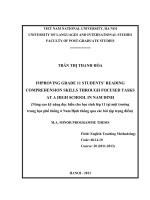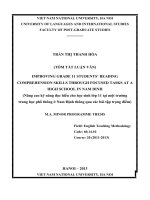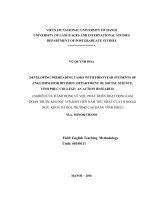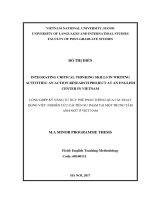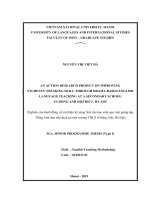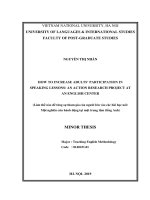Improving students’ extensive reading skills at a lower secondary school in Nam Dinh: An action research project
Bạn đang xem bản rút gọn của tài liệu. Xem và tải ngay bản đầy đủ của tài liệu tại đây (624.99 KB, 13 trang )
IMPROVING STUDENTS’ EXTENSIVE READING SKILLS AT A
LOWER SECONDARY SCHOOL IN NAM DINH: AN ACTION
RESEARCH PROJECT
Vũ Thị Dung*
Faculty of Post- graduate, University of Languages and International Studies, Vietnam
National University, Hanoi
Abstract: The current study aimed at investigating the effects of collaborative learning activities on
students’ extensive reading skills and EFL students’ perceptions towards the use of collaborative learning in
students’ extensive reading learning. To obtain research objectives, the researcher adopted an eight-week action
research project with the quantitative method. 25 Grade 8 students from a lower secondary school were selected
as the research participants. Two research instruments utilized for data collection included pre-test and posttest and questionnaire. Data analysis revealed the following research findings: 1) There was an increase in
score of students’ extensive reading tests after using collaborative learning as the treatment; 2) Students
expressed their positive perceptions towards the use of collaborative learning to promote students’ extensive
reading skills; and 3) Students tended to use collaborative learning activities in their further extensive reading
learning. Research findings generated the implications for the effective use of collaborative learning activities
to promote students’ extensive reading skills and overall reading competence.
Keywords: collaborative learning, reading competence, extensive reading skills, lower secondary
school, action research
1. Introduction
According to Dickinson (2017), reading is one of the most crucial skills a person should
acquire and master since it is an input-enabling process that allows readers to capture information
and broaden academic knowledge. In particular, a wide range of second/foreign language (L2)
studies (Cain, 2010; Dickinson, 2017; Moreillon, 2019; Yamashita, 2018) affirm that reading is not
only vital and of great significance to English as a Second Language (ESL) or English as a Foreign
Language (EFL) learners’ comprehension and information acquisition purposes but to students’
improvement in language competencies as well. Gayo et al. (2014) argue that through reading,
ESL/EFL learners can access a source of vocabulary, grammar and background knowledge for the
development of other language skills such as writing and speaking. Accordingly, reading skill greatly
contributes to the overall improvement of language competence of ESL/EFL learners. According to
Harmer (2002), reading is classified into two major types, including intensive and extensive reading.
While the former refers to “reading in detail” (Grellet, 2010, p.4), the latter is known as free reading
outside the classroom setting (Krashen, 2004). While intensive reading is widely used in the
classroom to promote learners’ reading comprehension, extensive reading is utilized as the
supportive approach to intensive reading (Grabe, 2010; Liao & Wang, 2020). Regarding extensive
reading, recent studies indicate that it significantly improves language learners’ exposure to authentic
reading materials, contributing to their development of vocabulary gains, reading comprehension,
and proficiency (Alzu’bi, 2014; Fakhruldeen, 2021). Despite the importance and significance of
extensive reading, ESL/EFL learners have still struggled to improve their reading extensive skills
(Liao & Wang, 2020).
Different learning and teaching methods have been utilized by English teachers to promote
students’ extensive reading skills; among these methods, collaborative learning is perceived as one
of the most effective ones (Fakhruldeen, 2021; Liao & Wang, 2020; Pongsatornpipat, 2021).
According to Jacobs and Tan (2015), collaborative learning involves a learning approach in which
students are grouped into small groups with their peers to perform a task or obtain a learning
objective. Collaborative learning requires students to be responsible for their own and others’
learning progress. Feri1 and Erlind (2014) explain that collaborative learning establishes a learning
environment in which all students are involved in tasks, work and communicate with other group
members and learn from others. Furthermore, collaborative learning is more than the intersection of
common goals; instead, goals are obtained in nature by sharing knowledge, learning and building
consensus (Macías et al., 2018). In particular, previous studies reveal that collaborative learning is
appropriate and applicable in different language learning settings (Lin, 2019). Therefore, it can be
assumed that the implementation of collaborative learning is beneficial to students’ improvement of
extensive reading skills (Fakhruldeen, 2021; Liao & Wang, 2020; Lin, 2019; Pongsatornpipat, 2021).
At Tan Thanh - A Lower Secondary School in Nam Dinh Province, the preliminary study
reveals that students’ extensive reading skill is low due to time constraints and overemphasis on
intensive reading activities within the classrooms. In addition, students perceive reading as a boring
learning activity, leading to their lack of motivation and engagement to reading tasks. Particularly,
in reading lessons English teachers still employ traditional methods in teaching; students’ autonomy,
creativity, and interactions are not encouraged during the lessons. Furthermore, the design of
curriculum and textbook does not facilitate extensive reading, To tackle these issues, the researcher
employed an action research project with the use of collaborative learning as the treatment in eight
weeks with Grade 8 students at Tan Thanh - A Lower Secondary School in Nam Dinh Province to
make reading activities become more encouraging and attractive, contributing to the students’
improvement in extensive reading skill. For all the explanations above, the current study was
performed to understand the impacts of using collaborative learning on students’ improvement in
extensive reading skills and their perceptions towards the use of collaborative learning in extensive
reading. To obtain these objectives, the following research questions are generated:
●
To what extent does the use of collaborative learning impact students’ improvement
in extensive reading skills?
●
What are students’ perceptions towards the use of collaborative learning in extensive
reading?
2. Literature review
2.1 Reading
The proliferation of studies in the domain of reading comprehension in ESL/EFL has created
a number of definitions and multifaced ideas on reading. The researcher can define reading based on
the approaches of comprehension, whether bottom-up or top-down, or bottom-up, or the levels of
comprehension.
Reading comprehension, as defined by Wooley (2011, p.4), is "the process of extracting
ideas within a text in order to gain the overall understanding of a text rather than to get the word-byword meaning of a text." Prior knowledge is essential to give impact on developing the meaning of
this process as it is formed within the reader's head. The understanding is highly dependent on the
reader, the text, and the situation.
According to Davoudi and Yousefi (2015), reading is an interactive process that involves
not only the reader but also the author. During this process, the reader is responsible for first
comprehending the meaning of the piece and then deciphering it. In addition, it is a dynamic process
in which information from the text and knowledge acquired by the reader interact to enable the reader
to build meaning prior to, during, and after the act of reading. It has been argued that reading is the
primary activity responsible for the growth of vocabulary, proficiency in spelling and writing, and
the ability to understand and construct complex grammatical structures (Cain, 2010; Dickinson,
2017).
Schallert (2013) also defines reading comprehension as the process of calls ting mind
memories of tracing letters, of sounding out letters, of beginning to sound out words and eventually
reading and comprehending texts (top-down) or having a grasp of phonics, spelling and the alphabet
to engage with any text (bottom-up)
2.2 Extensive reading
Reading is classified into intensive reading and extensive reading (Nuttall, 2005). According
to Macalister (2015), when students participate in intensive reading activities, they are typically
exposed to relatively short texts that are used to represent specific features of the lexical, syntactic,
or discoursal system of the L2, or to provide the impression for targeted reading approach practice.
In contrast, when students participate in extensive reading activities, they are exposed to large
amounts of L2 involvement with little to no specific tasks to achieve on this material.
Elements of extensive reading that are consistent with Day and Bamford's (2002) ten
requirements were emphasized by Stoller (2015). To begin, students are more likely to practice their
reading comprehension skills if the resources they use to do so are engaging, easily understood, and
enjoyable to read. Second, letting students read whatever they want is one way to encourage reading
in the classroom. Third, students can be inspired to read on their own when teachers serve as role
models by discussing the materials they've been reading. The significance of rereading is the next
factor to consider. Many people believe that rereading is one of the finest strategies to improve
reading fluency and the quality of what is read. Instead of usual post-activities like filling in the gaps
in a reading log, Stoller (2015) advocated that students be asked to reread texts for alternative goals,
such as recognizing the primary concept, locating details, or the writer's attitude, or comparing other
works. The final factor is whether or not students live up to their teachers' expectations. This means
that teachers should push their students to their full potential while also providing ample support for
their efforts. It is hoped that this will boost their self-esteem and provide them with the impetus they
need to improve their reading skills.
During the past decade, the efficiency of extensive reading has been questioned; nonetheless,
meta-analysis studies conducted during this time have shown its effectiveness in improving reading
ability. Several studies (Nakanishi, 2015; Jeon and Day, 2016; Suk, 2017) used a variety of contexts
and research subjects to determine the effects of extensive reading on the reading skills of language
learners. Empirical research uncovered the positive effects of extensive reading on the linguistic
proficiency, vocabulary, and reading speed of readers. Additionally, students indicated positive
perceptions towards extensive reading activities.
2.3 Collaborative learning
According to Barrot (2016), collaborative learning is a type of learning in which students are
allocated to work in groups and with peers to complete learning activities in order to attain a learning
goal. Collaborative learning enables students to express themselves to their peers and actively
communicate in order to absorb and use information to attain the desired learning outcome (La Hanisi
et al., 2018). Meanwhile, teachers can provide some assistance and finally cater to scaffolding
exercises to enhance students' learning independence (Reynolds, 2015). This suggests that
collaborative learning has been found to have a significant impact on students' growth in a variety of
areas, including social skills development (Macas et al., 2018). As a result of studying and working
together, students' social skills may improve. Furthermore, collaborative learning allows pupils to
study more deeply and develop higher-order thinking skills (Shih & Reynolds, 2015). However,
unique abilities are necessary to facilitate collaborative learning. Well-planned collaborative learning
allows for good peer communication, peer evaluation, problem-solving, and the possibility that
students begin to teach each other to maximize their learning capability (La Hanisi et al., 2018).
Collaborative learning is an effective method for teaching reading comprehension. It is an
activity in which students collaborate to complete a task and accomplish a predetermined learning
goal. It is a recursive action in which two or more people collaborate to achieve shared goals; this is
more than the intersection of similar goals observed in nature by exchanging knowledge, learning,
and reaching consensus (Jacobs & Tan, 2015). Most collaboration necessitates leadership, however
this can take the shape of social leadership within a student group (Widiastuti, 2018). Collaborative
teamwork, in particular, can help students improve their interpersonal skills.
Collaborative learning has been effectively applied in a wide range of classrooms. According
to Barrot (2016), it is reasonable to infer that collaborative learning is an excellent reading technique
for kids. It is distinctive in its emphasis on structuring peer discussion through the use of cooperative
learning roles and procedures, and it encourages students to be engaged in enquiring, interpreting
material and concepts, and developing higher thinking to attain learning objectives. Teachers should
adequately assess students to guarantee they have comprehension and ability in learning and can
eventually encourage their learning (Reynolds, 2015). As a result, students can improve their critical
thinking skills by completing appropriate kinds of learning through collaborative learning.
Given the benefits of collaborative learning as well as the use of collaborative learning in
English language teaching as revealed by some researchers (Jacobs & Tan, 2015; La Hanisi et al.,
2018; Lin, 2019), an in-depth study to improve students' reading comprehension through
collaborative learning is necessary. Furthermore, although there are many studies exploring the
effects of using collaborative learning to improve students’ extensive reading skill (Fakhruldeen,
2021; Liao & Wang, 2020; Lin, 2019; Pongsatornpipat, 2021), hardly any study has employed lower
secondary education in Vietnam as the research setting. Therefore, the current study attempted to
examine and understand the impacts of using collaborative learning on students’ improvement in
extensive reading skills and their perceptions towards the use of collaborative learning in extensive
reading to fill the literature gap.
3. Methodology
3.1. Research design
In the current study, in order to obtain research objectives action research was selected as
the research design. According to Winter (2007, p. 4), “action research is a process of self-reflective
inquiry study conducted by teachers to improve the rationality and legitimacy of the methods or
pedagogical situations they encounter in their teaching activities”. The researcher in the current study
identified the problems with extensive reading skill of students at Tan Thanh - A Lower Secondary
School in Nam Dinh Province and would like to test whether collaborative learning was employed
as the intervention in the normal learning process of reading at Tan Thanh - A Lower Secondary
School in Nam Dinh Province. The action research took place in eight weeks. At the end of the
research, the effects of using collaborative learning on students’ extensive reading skills and their
perceptions towards the use of collaborative learning in learning extensive reading. Quantitative data
was collected for the understanding of the effects of collaborative learning on students’ extensive
reading skills.
3.2. Participants
The researcher randomly selected 25 Grade 8 students from 8B Class at Tan Thanh - A
Lower Secondary School in Nam Dinh province. Before selecting the participants, the researcher
explained the objectives and procedures of the research to the students. Participant selection was
performed based on the students’ willingness. Participants were relatively homogeneous in their
cultural and learning backgrounds. All of them were living in Nam Dinh Provice and were
Vietnamese students. Furthermore, all of participants have learnt English since Grade 3 and have the
similar English proficiency. They are also taught English with the same textbooks and curriculum.
Among 25 students, 17 students were female while the rest were male. Furthermore, 20 out of 25
students affirmed that they spent more than one hour per day on extensive reading.
3.3. Research instruments
There were two research instruments utilized by the researcher for data collection, including
pre- and post-test, questionnaire, and interview. Firstly, pre- and post-test were used to measure the
students’ reading performance before and after action research to investigate how students’ reading
competence was improved by the intervention of using collaborative learning activities. Pre- and
post-tests were designed in the same format with 40 multiple choice questions and the allotted time
for each test was 60 minutes. The tests were designed based on the A2 level of the Common European
Framework of Reference (CEFR).
The second research instrument referred to the questionnaire which was used to explore the
students’ perceptions towards the effects of collaborative learning to promote lower secondary
students’ extensive reading skills. There were two sections in the questionnaire. In the first section,
the researcher employed two items to explore students’ demographics, including gender and time
spent for extensive reading. The second section included ten items adopted from the study by
Fakhruldeen (2021). This section investigated how the use of collaborative learning promoted
students’ learning motivation, autonomy, learning environment, reading strategies, and aspects of
extensive reading performance as well. All questionnaire items in the second section were designed
in five points Likert scale in the negative orientation ranging from 1 – Strongly disagree to 5 –
Strongly agree.
3.4. Data collection and data analysis
Data collection consisted of the following steps:
●
Performing pre-test to measure the students’ performance before the action research.
●
Performing the action research with the use of collaborative learning to promote extensive
reading skills in eight weeks.
●
Administering post-test to measure the effects of collaborative learning on students’
extensive reading skills.
●
Conducting the questionnaire with 25 students
Concerning data analysis, data was analyzed per research instrument. Results from pre- and
post-tests were recorded and processed through SPSS 200 with the use of means to measure the
students’ reading performance. Additionally, t-test was performed to understand whether there was
a difference in students’ pre- and post-tests’ results before and after the action research. In terms of
results from the questionnaire, descriptive statistics with mean values were used to understand
students’ perceptions towards the effects of collaborative learning on promoting extensive reading
skills.
4. Findings and discussions
4.1. Students’ extensive reading skills
To measure the effects of collaborative learning on promoting extensive reading skills,
results of pre- and post-tests were recorded and compared. Details were included in Appendix C. In
pre-test, among 25 students participating in the action research five students, accounting for 20%,
only received less than 20 marks over 40 while the percentage of participants gaining over 30 marks
was 20% accordingly. After eight weeks of extensive reading with collaborative learning activities,
the number of students with under average scores reduced to only two students, making up for 8%.
Furthermore, the number of students with excellent performance (over 30 mark) was six students,
representing 24%. The test results indicated that the use of collaborative learning activities had
positive impacts on students’ extensive reading performance. The effects were further affirmed with
descriptive statistics and paired sample test results (Table 1 and Table 2).
Table 1. Descriptive statistics of pre-test and post-test
Descriptive
Pre-test
Post-test
Mean
Median
Mode
Standard Deviation
Range
Minimum
Maximum
Count
24.04
23
23
5.36
17
17
34
25
26.16
25
23
5.15
17
18
35
25
Table 2. The Paired Samples Test
Paired differences
Mean
Pair 1
-7.628
SD
t
Sig. (2-tailed)
5.713
-6.287
.000
Pre-test – Post-test
It was reported in Table 1 that results of pre-test (M = 24.04; SD = 5.36) and post-test (M =
26.16; SD = 5.15) showed that there was a significant increase in the participants’ extensive reading
performance with the intervention of collaborative learning activities. Furthermore, results of paired
sample tests (t = -6.287; p = .000) indicated that there was a significant difference between the
participants’ pre-test and post-test results. This finding was supported by previous studies concerning
the use of collaborative learning to promote students’ extensive reading. Pongsatornpipat (2021)
performed an action research that examined the use of interactive groups as an assortment of
collaborative learning to improve students’ extensive reading skills. Results of pre-test and post-test
of 30 Thai EFL students affirmed the increase in performance of participants. In the same line, the
research by Liao and Wang (2020) with Taiwanese students also revealed the positive impacts of
collaborative learning on students’ extensive reading performance.
4.2. Students’ perceptions towards the use of collaborative learning to promote students’
extensive reading skills
Table 3 showed descriptive statistics of students’ perceptions towards the use of
collaborative learning to promote students’ extensive reading skills.
Table 3. Students’ perceptions towards the use of collaborative learning to promote students’
extensive reading skills
No.
1
2
3
4
5
6
7
8
9
10
Statements
I become more motivated to learn extensive reading because of
collaborative learning activities.
Reading learning environment is more flexible and encouraging
because of collaborative learning activities.
I can access more authentic reading materials in extensive reading
because of collaborative learning activities.
When the teacher employs collaborative learning activities in
extensive reading, I gain more learning autonomy.
My reading strategies used in extensive reading are significantly
improved by integrating collaborative learning activities.
My fluency of extensive reading is improved by using collaborative
learning activities.
My reading speed of extensive reading is improved by using
collaborative learning activities.
My accuracy of extensive reading is improved by using
collaborative learning activities.
My overall performance of extensive reading is improved by using
collaborative learning activities.
I would like to use more collaborative learning activities in learning
extensive reading in the future.
M
4.16
SD
.54
4.41
.59
4.53
.48
4.03
.61
4.11
.73
4.08
.45
4.05
.56
4.03
.47
4.38
.54
4.47
.32
(M – Mean; SD – Standard Deviation)
As shown in Table 3, mean values of all questionnaire items ranged from 4.03 to 4.53,
implying the participants’ agreement towards the impacts of using collaborative learning to promote
students’ extensive reading skills with reference to the improvement in learning motivation (M =
4.16; SD = .54), learning environment (M = 4.41; SD = .59), access to authentic reading materials
(M = 4.53; SD = .48), learning autonomy (M = 4.03; SD = .61), reading strategies (M = 4.11; SD
= .73), reading fluency (M = 4.08; SD = .45), reading speed (M = 4.05; SD = .56), reading accuracy
(M = 4.03; SD = .47), and overall reading performance (M = 4.38; SD = .54). Owing to the positive
impacts of collaborative learning on students’ extensive reading skills, students expressed their
intention to use collaborative learning activities in their further extensive reading learning (M = 4.47;
SD = .32). These findings were aligned with the findings found in the study by Fakhruldeen (2020)
that examined EFL students’ and teachers’ attitude towards how collaborative learning activities
were utilized to improve students’ extensive reading skills. This study affirmed that because students
realized the positive impacts of collaborative learning; therefore, students had the positive
perceptions of using collaborative learning activities to promote students’ extensive reading skills.
To sum up, data collected from the tests and questionnaires affirmed that the use of
collaborative learning activities promoted lower secondary students’ extensive reading skills and
students had positive perceptions towards the use of collaborative learning activities in learning
extensive reading skills.
5. Conclusion
To sum up, extensive reading is beneficial to EFL students’ reading ability as well as
language competence overall. However, it is challenging for students to improve students’ extensive
reading skills. Among different methods, previous studies revealed that collaborative learning
activities were effective tools employed by EFL students and teachers to improve students’ extensive
reading skills. Therefore, the current study was conducted as an eight-week action research with the
intervention of collaborative learning activities to understand the impacts of using collaborative
learning on students’ extensive reading performance and students’ perceptions towards the use of
collaborative learning. 25 Grade 8 students at a lower secondary school in Nam Dinh were selected
as research participants. The quantitative data was collected from pre- and post-tests and close-ended
questionnaire. Research results indicated the following findings: 1) There was an increase in score
of students’ extensive reading tests after using collaborative learning as the treatment; 2) Students
expressed their positive perceptions towards the use of collaborative learning to promote students’
extensive reading skills; and 3) Students tended to use collaborative learning activities in their further
extensive reading learning.
Based on research findings, it is suggested that to improve students’ overall reading
competence the teachers should encourage students to employ collaborative learning activities in
their extensive reading. Firstly, teachers should assign students in appropriate small groups
facilitating students’ collaborative learning in extensive reading. Secondly, the teachers should act
as the facilitator in students’ reading process to provide more learning autonomy to study when
learning extensive reading with collaborative learning activities. Finally, more sources of authentic
materials should be provided to the students to encourage the learning of extensive reading.
The current study generated important findings concerning the impacts of collaborative
learning activities on students’ extensive reading skills and students’ perceptions; however, there
were some limitations in the current study. Firstly, the study employed the sole quantitative research
method, influencing the validity and reliability of research findings. Secondly, the action research
only took place in eight weeks; the impacts of using collaborative learning activities on students’
extensive reading skills were not thoroughly investigated. Therefore, it is suggested that in further
studies, the researchers should perform a longer research period with the use of both quantitative and
qualitative methods to obtain more reliable findings.
References
Alzu’bi, M. A. (2014). The effects of an extensive reading program on improving English as a foreign
language proficiency in university level education. English Language Teaching, 7(1), pp. 28-35.
Barrot, J. S. (2016). ESL learners’ use of reading strategies across different text types.
The Asia-Pacific Education Resercher, 25(5-6), 883-892
/>Cain, K. (2010). Reading development and Difficulties. London: BPS Blackwell.
Davoudi, M., & Yousefi, D. (2015). Comprehension Breakdown: A Review of Research on EFL
Learners’ Reading Difficulty and Problems. International Journal of Language and Applied
Linguistics, 1, 58-72.
Dickinson, P. (2017). Effects of extensive reading on EFL learner reading attitudes. In Selected
Papers of the 21st Conference of Pan-Pacific Association of Applied Linguistics (pp. 28-35).
Fakhruldeen, M. A. (2021). Using Collaborative Learning Strategies in Improving EFL Learning
Skills. International Journal of Scientific & Technology Research, 10(3). Retrieved from
/>Feri, Z. O., & Erlinda, R. (2014). Building Students’ Learning Autonomy through Collaborative
Learning to Develop Their Language Awareness. Proceedings of ISELT FBS Universitas Negeri
Padang, 2, 518-523.
Gayo, E., Deano, M., Conde, A., Ribeiro, I., Cadime, I. and Alfonso, S. (2014). Effect of an
intervention program on the reading comprehension processes and strategies in 5th and 6th grade
students. Psicothema, 26(4), pp. 464-470.
Grabe, W. (2010). Fluency in reading: Thirty-five years later. Reading in a Foreign Language, 22(1),
pp. 71-83.
Grellet, F. (2010). Developing Reading Skills: A Practical Guide to Reading Comprehension
Exercises. Cambridge: Cambridge University Press.
Harmer, J. (2002). The Practice of English Language Teaching. (3rd Ed). London: Longman.
Jacobs, G. M., & Shan, T. H. (2015). Advancing Learner Autonomy in TEFL via Collaborative
Learning. Iranian Journal of Language Teaching Research, 1(1), 27-43
Krashen, S. D. (2004). The power of reading: insights from the research (2nd ed.). Libraries
Unlimited.
La Hanisi, A., Risdiany, R., & Sulisworo, D. (2018). The use of WhatsApp in collaborative learning
to improve English teaching and learning process. International Journal of research, 7(1), 29-35.
/>Lin, S. F. (2019). Students' Attitudes towards Learning English Vocabulary through Collaborative
Group Work versus Individual Work. Journal of Education and Learning, 8(4), 93-111.
Macalister, J. (2015). Guidelines or commandments? reconsidering core principles in extensive
reading. Reading in a Foreign Language, 271(1), 122-128.
Macías, E. I. P., Cedo, H. A. C., & Chávez, G. M. R. (2018). Importance of Improving Resilience
in Teaching Learning Process of Students with Disabilities. International Research Journal of
Management, IT and Social Sciences, 5(2), 120-128.
Moreillon, J. (2019). Reading comprehension at the core of the library program. School Library
Monthly, 29(2), pp. 5-8.
Nakanishi, T. (2015). A meta-analysis of extensive reading research. TESOL Quarterly, 49(1), 6-37.
Pongsatornpipat, W. (2021). Interactive group in extensive reading to enhance reading ability of Thai
undergraduate students. LEARN Journal: Language Education and Acquisition Research Network,
14(2), 342-371.
Reynolds, B. L. (2015). A mixed‐methods approach to investigating first‐and second‐language
incidental vocabulary acquisition through the reading of fiction. Reading Research Quarterly, 50(1),
111-127. />Shih, Y. C., & Reynolds, B. L. (2015). Teaching adolescents EFL by integrating Think-Pair-Share
and reading strategy instruction: A quasi-experimental study. RELC Journal, 46(3), 221-235.
/>Widiastuti, I. A. M. S. (2018). Teachers’ classroom assessment and grading practices. In SHS Web
of Conferences (Vol. 42, p.00052). EDP Sciences
/>
Winter, R. (2007). Action-Research and the Nature of Social Inquiry: Professional Innovation and
Educational Work, 12th ed. Aldershot: Gower Publishing Company, 1987.
Woolley, G. (2011). Reading comprehension: Assisting children with learning difficulties. New
York: Springer.
Yamashita, J. (2008). Extensive reading and development of different aspects of L2 Proficiency
System, 36(4). 661-672.
/>______________________________________________________________
NÂNG CAO KỸ NĂNG ĐỌC MỞ RỘNG CỦA HỌC SINH TẠI MỘT
TRƯỜNG THCS Ở NAM ĐỊNH: MỘT DỰ ÁN NGHIÊN CỨU HÀNH ĐỘNG
Tóm tắt: Nghiên cứu hiện tại nhằm mục đích điều tra tác dụng của các hoạt động học tập hợp
tác đối với kỹ năng đọc mở rộng của học sinh và nhận thức của học sinh EFL đối với việc việc
sử dụng phương pháp học hợp tác trong học tập đọc mở rộng của học sinh. Để đạt được mục tiêu
nghiên cứu, nhà nghiên cứu đã thông qua một dự án nghiên cứu hành động kéo dài 8 tuần với
phương pháp định lượng. 25 học sinh lớp 8 từ một trường THCS được chọn làm người tham gia
nghiên cứu. Hai công cụ nghiên cứu được sử dụng để thu thập dữ liệu bao gồm kiểm tra trước,
kiểm tra sau và bảng câu hỏi. Phân tích dữ liệu cho thấy kết quả nghiên cứu sau: Thứ nhất, có sự
cải thiện về điểm số trong các bài kiểm tra đọc mở rộng của học sinh sau khi sử dụng phương
pháp học tập hợp tác; Thứ hai, học sinh bày tỏ nhận thức tích cực của mình đối với việc sử dụng
phương pháp học tập hợp tác để thúc đẩy các kỹ năng đọc hiểu sâu rộng của học; Cuối cùng, học
sinh có xu hướng sử dụng các hoạt động hợp tác trong quá trình học đọc sâu rộng hơn của họ.
Kết quả nghiên cứu đã tạo ra những ý nghĩa cho việc sử dụng hiệu quả các hoạt động học tập
hợp tác để thúc đẩy các kỹ năng đọc sâu rộng và năng lực đọc tổng thể của học sinh.
